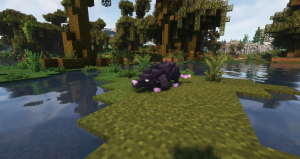Giant Rat
| Class | Vermin |
| Rarity | Rare |
| Size | Large |
| Stats |
10 HP 6 Strength 8 Defense 6 Agility 6 Intelligence |
Habitat
The giant rats like to live in cooler, damp places, such as dark, cool caves. Since the giant rats are so large, there are few places where they can live very comfortably and often have to create their own place to live.
For example, these rodents dig burrows close to river banks and trees or just anywhere in the ground. Their nests are then built in these burrows in which the little ones are raised until they can live independently.
Description
Giant rats, like normal rats, are rodents. In contrast to its much smaller cousin, there are many differences between the common and the Giant rat.
For starters, giant rats already have a much larger head than the average rat. The rat's head alone measures 125 cm and its ears can reach heights of 25 cm. These ears have a round shape and end in openings in the side of the head, where the hearing organ resides. A giant rat has two black beady eyes and a long snout, which can extend to 50 cm and have whiskers about 30 cm long; the tip of the rat’s snout is the only part of its that doesn’t grow fur.
The rest of the rat's body is covered with relatively thin fur. This often varies in color in shades of brown, gray or black, sometimes with spots. The body of the rat has a total length of 2m, while its tail can measure up to 2.5m. Rats have, in relation to the rest of the body, fairly short legs, namely 75 cm.
=Begaviour
Giant rats reproduce year-round, as long as there is plenty of food available and temperatures are not extreme. The gestation period for a pregnant rat is 21 to 23 days. A female can have one to twenty young per litter, but usually there are seven to twelve young per litter. Females can re-fertilize every four to six months, even if they are still nursing their young. This can lead to more than 24 young per year per female. Since young rats reach sexual maturity quickly (from 6 weeks), the total number of offspring in a year for a pair and their offspring can be as many as 4 animals. The young are born blind and naked.
After about twelve to fourteen days they open their eyes and are completely hairy. The growth of the young is affected by the size of the litter, and young in smaller litters often grow faster. Only the female cares for the young, and she will chase away intruders or move young when disturbed. In addition, their intelligence and adaptability allow them to adapt even better. They even exhibit behaviors that can be considered traditions, meaning that certain populations can develop and pass on different behaviors, eating habits, and hunting techniques from generation to generation.
In general, they eat just about anything they can find, but are mainly attracted to dirt. So there is a chance that the giant rat can sometimes come quite close to towns or villages, although you won't see them often. They are mainly active at night. From just after the sun sets until just before the sun rises again. The rat generally adapts easily to other living environments. For example, rats are very good swimmers and can also climb and jump well. Just like their smaller versions they are able to spread diseases. This is more complicated for the giant ones, because of their size.
Abilities
Bite The Giant rat makes a melee attack that deals D6 damage.
Scratch A giant rat makes a melee attack that deals D3 damage to two targets.
Tail Whip A blow from a rat's tail can be very powerful. A Giant Rat makes a melee attack against up to two adjacent targets in melee range, dealing d4 damage.
Disease carrier A Giant rat might seldom carry diseases with its scratches or bites, see also Diseases
Drops
The drop of a giant rat consists of its teeth, which can be used to make several objects. It is also possible to take its fur, which is a fairly large surface area of fur that can easily be used for a coat, for example.
